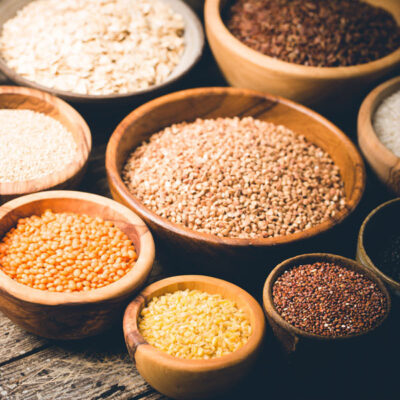Brands
Soda Bread Simplified. Quick Bread Without Yeast.
By: admin On: 7 July 2024

Quick, easy and versatile, soda bread is an ideal choice for anyone looking to bake tasty fresh bread in a hurry. Here's how. Tried Soda Bread?
If you have never had soda bread, let alone made it, then you are in for a surprise! Fresh, warm bread on the table in less than 40 minutes. But is it like real bread? Yes, it really is.
What is Soda Bread?
Soda bread is a simple type of quick bread that doesn't require the usual hours of rising that you expect from traditional yeast bread. Originating from Ireland, this bread gets its name from the baking soda used as a leavening agent. When combined with the acid in buttermilk, the baking soda reacts, producing carbon dioxide and causing the dough to rise quickly. This process gives soda bread its distinctive texture and flavour.
With its ease and speed of preparation, as well as its versatility, soda bread is an ideal choice for anyone looking to bake tasty fresh bread in a hurry.
What does soda bread taste like?
Soda bread has a distinctively rugged, yet tender texture that's quite unlike other breads. Its taste can vary depending on the recipe. Without additions, it has a robust, earthy flavour. The crust is typically crisp and golden, providing contrast to the soft, yet dense interior.
The Key Ingredients for Soda Bread
Flour
The flour used in soda bread determines the final texture and flavour, giving it its unique character. Traditionally, wholemeal flour is used, for a rich, nutty taste and a dense texture. However, you can easily adapt this by mixing in some white flour, which lightens the loaf, for a softer crumb.
Baking Soda
Also known as bicarbonate of soda (not baking powder) baking soda gives soda bread its rise, as well as its name. Acting as a powerful leavening agent, it reacts with the acidity of the buttermilk, releasing carbon dioxide gas. This chemical reaction not only helps the dough to rise quickly but also contributes to the unique texture and slightly tangy taste that is characteristic of soda bread.
Buttermilk
Buttermilk acts as far more than just a wet ingredient. It's the acid in buttermilk that reacts with the alkaline baking soda to create that essential rise. Without this reaction, you'd end up with a very flat, dense loaf. Beyond its scientific function, buttermilk also contributes to the bread's distinct taste and tenderness. Its tangy flavour balances the earthiness of the flour and adds a slight richness to the crumb.
Salt
As a flavour enhancer, salt is crucial for balancing the bread's overall taste, preventing it from becoming bland. More than just a seasoning, salt also strengthens the dough by tightening the gluten structure, making for a better-textured loaf that holds its shape well during baking. It's the subtle sharpness of salt that complements the tanginess of the buttermilk and the earthy tones of the flour, bringing out the best in each ingredient. A pinch too little, and the bread could taste flat; too much, and it might disrupt the distinctive balance of flavours.
Can you make soda bread if you don't have buttermilk?
Absolutely, you can still make soda bread without buttermilk.
A fantastic substitute is to mix a bit of lemon juice or white vinegar with milk—approximately 1 tablespoon of acid for every cup of milk. Stir it and let it sit for about 10 minutes; you'll notice it starts to thicken and curdle slightly, mimicking the consistency and acidity of buttermilk.
Alternatively, you can mix plain yoghurt with milk. Just enough to thin it down to a similar consistency.
Basic Soda Bread Recipe
Buns are the best route to bread in a hurry, and they also seem to encompass all that is good about soda bread. Split apart whilst warm, with a slather of butter, they make the ideal accompaniment to your meal.
The dough will keep in the fridge, so you can just bake off six if you wish and bake off the other six the next day.
We use a blend of white and wholemeal spelt flour, plus a little rye for extra flavour. A handful of oats adds softness and a professional-looking finish.
Recipe for Spelt and Rye Soda Bread Rolls
Makes 12 rolls
2 cups white spelt flour
3/4 cup wholegrain spelt flour
3/4 cup wholemeal rye flour
80g rolled oats
2 tsp baking soda
2 tsp flaked sea salt
1 3/4 cups buttermilk
- Preheat the oven to 190C/375F/Gas 5.
- Line a baking sheet with baking parchment.
- Add all the dry ingredients to a bowl, and mix well.
- Make a well in the centre, add the buttermilk, and mix until just combined.
- Turn the dough onto a floured surface and divide into two.
- Shape gently into two sausage shapes and divide each into six for a total of 12 rolls.
- Roll into balls, flatten slightly, and place on the baking tray.
- Brush each roll with water and scatter with oats.
- Bake for 20 minutes, until they are well browned. When you tap the bottom it will sound hollow.
- Transfer to a wire rack to cool slightly before serving.
Variations of soda bread
You can add all sorts of things to your basic soda bread recipe, stirring them in as you mix in your buttermilk. Chopped fresh herbs work particularly well, and savoury things such as chopped olives or crumbled cheese. Or you could sweeten them up a little, by adding dried fruits. Here are a few ideas to get you started.
Cheese and Chives
Stir in 1 cup of grated sharp cheddar and 1/4 cup of finely chopped chives.
Olive & Rosemary
Add 1/2 cup of chopped kalamata olives and 1 tablespoon of chopped, fresh rosemary.
Sweet Cranberry and Orange
For a sweeter roll, mix in 3/4 cup of dried cranberries and the zest of one orange.
Spicy Jalapeño & Corn
Add 1/2 cup of finely chopped jalapeños and 1/2 cup of sweet corn to give your rolls a spicy kick with a sweet balance.
So next time that you really wish you had bought some bread, we hope you are tempted to give soda bread a go. Trust us, it will totally save the day.
Got the baking bug? Check out some of our other healthy baking ingredients. Or read our beginners' guide to getting started with healthy baking.






